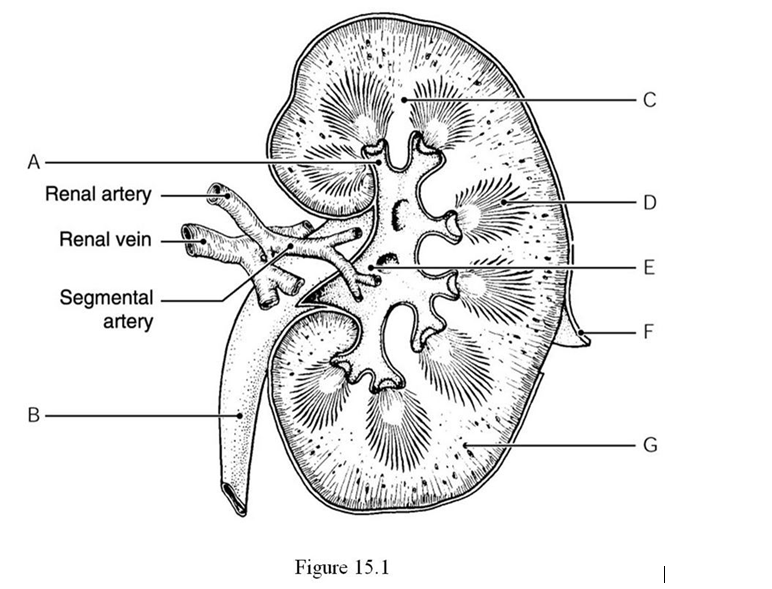A) cystitis
B) anuria
C) hypospadias
D) glycosuria
E) adult polycystic kidney disease
G) A) and C)
Correct Answer

verified
E
Correct Answer
verified
Multiple Choice
 Using Figure 15.1, identify the following:
-The renal pelvis is indicated by ________.
Using Figure 15.1, identify the following:
-The renal pelvis is indicated by ________.
A) Label E
B) Label A
C) Label G
D) Label F
E) Label B
G) C) and D)
Correct Answer

verified
Correct Answer
verified
Multiple Choice
 Using Figure 15.1, identify the following:
-The renal cortex is indicated by ________.
Using Figure 15.1, identify the following:
-The renal cortex is indicated by ________.
A) Label F
B) Label G
C) Label D
D) Label E
E) Label A
G) None of the above
Correct Answer

verified
Correct Answer
verified
Multiple Choice
Starting from the glomerular (Bowman's) capsule, the correct order of the renal tubule regions is ________.
A) proximal convoluted tubule, distal convoluted tubule, nephron loop (loop of Henle)
B) distal convoluted tubule, nephron loop (loop of Henle) , proximal convoluted tubule
C) nephron loop (loop of Henle) , proximal convoluted tubule, distal convoluted tubule
D) proximal convoluted tubule, nephron loop (loop of Henle) , distal convoluted tubule
E) distal convoluted tubule, proximal convoluted tubule, nephron loop (loop of Henle)
G) A) and B)
Correct Answer

verified
Correct Answer
verified
Multiple Choice
Which one of the following is NOT one of the functions of the kidneys?
A) manufacture urine
B) convert vitamin D from its inactive to its active form
C) dispose of metabolic waste products
D) produce hormones that assist in digestion
E) regulate blood volume
G) A) and C)
Correct Answer

verified
Correct Answer
verified
Essay
Identify these organs of the urinary system with their associated descriptions: A) ureter B) urinary bladder C) urethra -Contains an area called the trigone formed by the openings of the ureters and urethra
Correct Answer

verified
Correct Answer
verified
Multiple Choice
Antidiuretic hormone (ADH) prevents excessive water loss by promoting water reabsorption in the ________.
A) glomerulus
B) proximal convoluted tubule
C) distal convoluted tubule
D) collecting duct
E) urinary bladder
G) A) and B)
Correct Answer

verified
Correct Answer
verified
Multiple Choice
Which congenital condition is found in male babies only and arises when the urethral orifice is located on the ventral surface of the penis?
A) renal calculi
B) glomerulonephritis
C) hypospadias
D) cystitis
F) None of the above
Correct Answer

verified
Correct Answer
verified
Multiple Choice
Which of the following is NOT True of the differences between the male and female urethrae?
A) The male urethra is part of both the urinary and reproductive systems while the female urethra is only part of the urinary system.
B) The male urethra opens at the tip of the penis while the female urethra opens anterior to the vagina opening.
C) The male urethra transports both urine and sperm (but never at the same time) while the only function of the female urethra is to transport urine.
D) The male urethra has three different regions: prostatic, membranous, and spongy while the female urethra lacks these regions.
E) The male urethra is the same length as the female urethra.
G) A) and E)
Correct Answer

verified
Correct Answer
verified
Multiple Choice
Which one of the following substances is normally found in urine?
A) blood proteins
B) red blood cells
C) hemoglobin
D) white blood cells
E) creatinine
G) All of the above
Correct Answer

verified
Correct Answer
verified
Multiple Choice
What tube transports urine from the urinary bladder to the outside of the body?
A) ureter
B) distal convoluted tubule
C) proximal convoluted tubule
D) urethra
E) collecting duct
G) D) and E)
Correct Answer

verified
Correct Answer
verified
Multiple Choice
The kidneys can help maintain a blood pH which is approaching the alkaline end of its range by excreting ________ ions.
A) bicarbonate
B) oxygen
C) ammonia
D) hydrogen
F) A) and C)
Correct Answer

verified
Correct Answer
verified
True/False
Blood proteins and blood cells are too large to pass through the filtration membrane and should not be found in filtrate.
B) False
Correct Answer

verified
Correct Answer
verified
Multiple Choice
The process of emptying the urinary bladder is known as voiding or ________.
A) urgency
B) incontinence
C) micturition
D) nocturia
F) A) and C)
Correct Answer

verified
Correct Answer
verified
Multiple Choice
Filtrate contains everything in blood plasma EXCEPT for ________.
A) water
B) blood proteins
C) solutes
D) electrolytes
F) A) and D)
Correct Answer

verified
Correct Answer
verified
Multiple Choice
 Using Figure 15.1, identify the following:
-A calyx is indicated by ________.
Using Figure 15.1, identify the following:
-A calyx is indicated by ________.
A) Label G
B) Label F
C) Label A
D) Label B
E) Label C
G) A) and D)
Correct Answer

verified
Correct Answer
verified
True/False
The bicarbonate buffer system prevents changes in blood pH through the action of carbonic acid and its salt, sodium bicarbonate.
B) False
Correct Answer

verified
Correct Answer
verified
True/False
The peritubular capillary bed arises from the afferent arteriole.
B) False
Correct Answer

verified
False
Correct Answer
verified
Multiple Choice
What blood vessel carries blood from the aorta into the kidney?
A) hepatic artery
B) renal artery
C) renal vein
D) glomerulus
F) A) and C)
Correct Answer

verified
Correct Answer
verified
Multiple Choice
What is the driving force for water intake?
A) metabolism
B) the thirst mechanism
C) the renin-angiotensin mechanism
D) glomerular filtration
F) A) and D)
Correct Answer

verified
B
Correct Answer
verified
Showing 1 - 20 of 138
Related Exams